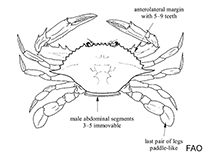Portunus armatus (Milne-Edwards, 1861)
Blue swimmer crab| Native range | All suitable habitat | Point map | Year 2050 |

|
| This map was computer-generated and has not yet been reviewed. |
| Portunus armatus AquaMaps Data sources: GBIF OBIS |
Google image | No image available for this species;
drawing shows typical species in Portunidae.
Classification / Names Common names | Synonyms | CoL | ITIS | WoRMS
Malacostraca | Decapoda | Portunidae
Environment: milieu / climate zone / depth range / distribution range Ecology
Benthic; depth range 0 - 50 m (Ref. 122760). Tropical; 9°S - 38°S, 112°E - 169°E
Distribution Countries | FAO areas | Ecosystems | Occurrences | Introductions
Indo-West Pacific: Australia and New Caledonia.
Length at first maturity / Size / Weight / Age
Maturity: Lm 9.6, range 9 - ? cm Max length : 22.0 cm CW male/unsexed; (Ref. 128184); max. reported age: 3.00 years (Ref. 128184)
Life cycle and mating behavior Maturity | Reproduction | Spawning | Eggs | Fecundity | Larvae
Main reference
References | Coordinator | Collaborators
Legall, N. and J. Poupin 2015 CRUSTA: Database of Crustacea (Decapoda and Stomatopoda), with special interest for those collected in French overseas territories. http://crustiesfroverseas.free.fr/ [Accessed 02/03/2015]. (Ref. 100230)
IUCN Red List Status
(Ref. 130435: Version 2025-1)
CITES status (Ref. 108899)
CMS (Ref. 116361)
Threat to humans
Human uses
Fisheries: commercial
| FishSource |
Tools
More information
Max. ages / sizes
Length-weight rel.
Length-length rel.
Length-frequencies
Mass conversion
Abundance
Internet sources
BHL | BOLD Systems | CISTI | DiscoverLife | FAO(Publication : search) | Fishipedia | GenBank (genome, nucleotide) | GloBI | Gomexsi | Google Books | Google Scholar | Google | PubMed | Tree of Life | Wikipedia (Go, Search) | Zoological Record



